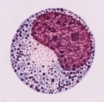| Features of the individual hemopoietic cells in the bone marrow |
Cells of the erythroid series from the bone marrow
Cells leading to the formation of erythrocytes or red blood cells |
 |
|
 |
Basophilic erythroblast (early) (15-20 µm)
- Large cell with a large spherical nucleus showing a stippled chromatin and one or two nucleoli.
- Cytoplasm deeply basophilic and free of granules.
|
 |
Basophilic erythroblast (late) (10-15 µm)
- Smaller cell with a spherical nucleus showing flaky chromatin that masks the nucleolus.
- Abundant cytoplasm deeply basophilic but paler than that of the early basophilic erythroblast.
|
 |
Polychromatophilic erythroblast (8-9 µm)
- Smaller cell with a partly condensed spherical nucleus.
- The cytoplasm is basophilic owing to ribosomes. It is slightly acidophilic owing to an increasing amount of hemoglobin. As a result of their mixed basophilic and acidophilic staining, these cells are said to be polychromatophilic.
(N.B.: The cells of the preceding three steps undergo from 4 to 6 consecutive mitoses.)
|
 |
Erythroblast (7-8 µm)
- Small discoid biconcave acidophilic cell with no nucleus.
|
 |
Erythrocyte
- Small flattened discoid cell with no nucleus.
- Acidophilic cytoplasm. Some erythrocytes called reticulocytes contain clusters of basophilic ribosomes (see Figure 7.8.)
|
Cells of the granulocyte series in the bone marrow
Precursors of neutrophils, eosinophils and basophils which contain specific granules |
 |
|
 |
Promyelocyte (precursor of the three granular leukocytes)
- Large spheroidal nucleus containing stippled chromatin and visible nucleolus or nucleoli.
- Abundant basophilic cytoplasm containing purple or azurophilic (lysosomal) granules.
|
| Cells of the neutrophil cell lineage |
 |
Neutrophil myelocyte (early)
- Slightly elongated nucleus, with or without a mid-depression, containing stippled chromatin and visible nucleolus or nucleoli.
- Cytoplasm is basophilic but paler than that of promyelocytes. Contains azurophilic granules and some small pale acidophilic specific granules which form in the juxtanuclear Golgi region.
|
 |
Neutrophil myelocyte (late)
- Owing to a deep identation, the nucleus is C-shaped and contains partly condensed chromatin flakes that mask the nucleolus.
- Cytoplasm is lighly stained and contains numerous fine acidophilic specific granules. This cytoplasm occasionally contains azurophilic granules.
|
 |
Band neutrophil (some can be seen in the blood smear)
- Elongated nucleus not segmented into lobules. Nucleus contains a flaky chromatin.
- Pale cytoplasm contains specific neutrophilic granules plus occasional azurophilic granules.
|
 |
Neutrophil
- Lobulated nucleus with condensed chromatin flakes.
- Pale cytoplasm with fine specific granules plus occasional azurophilic granules.
|
| Cells of the eosinophilic lineage |
 |
Eosinophilic myelocyte (early)
- Ovoid nucleus with stippled chromatin and visible nucleoli.
- Cytoplasm with a slightly basophilic background containing numerous large specific acidophilic granules. At this stage these granules may be greenish or brownish colour.
|
 |
Eosinophil myelocyte (late)
- Elongated deeply indented nucleus (but not lobed) containing flakes of condensed chromatin masking the nucleoli.
- Cytoplasm with a pale background containing numerous large acidophilic bright orange granules.
|
 |
Eosinophil
- Bilobed nucleus with partly condensed chromatin.
- Cytoplasm loaded with large acidophilic or orange specific granules.
|
| Cells of the basophilic lineage presumably derived from promyelocytes. |
 |
Basophilic myelocytes (early and late) (rare)
- Ovoid and partly indented nucleus containing stippled or partly condensed chromatin.
- Cytoplasm contains an increasing number of large azurophilic or metachromatic granules non-lysosomal in nature.
|














![]() The text and images of this Histology Atlas, by Yves Clermont,
Michael Lalli & Zsuzsanna Bencsath-Makkai,
are licensed under a
Creative Commons Attribution-Noncommercial-No Derivative Works 2.5 Canada Licence
and cannot be modified without the written permission of the authors.
Use of any text or images must carry an acknowledgement which includes a link to the original work.
The text and images of this Histology Atlas, by Yves Clermont,
Michael Lalli & Zsuzsanna Bencsath-Makkai,
are licensed under a
Creative Commons Attribution-Noncommercial-No Derivative Works 2.5 Canada Licence
and cannot be modified without the written permission of the authors.
Use of any text or images must carry an acknowledgement which includes a link to the original work.